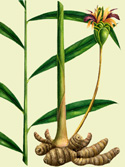| Latin Name | Zingiber officinale Rosc. (Zingiberaceae) |
| English Name | Ginger |
| Sanskrit Names | Sunthi, Ardraka, Vishvabheshaja, Nagara |
| Hindi Names | Adrak, Sonth |
 History: Ginger was known in China as early as 400 B.C. The Greeks and Romans, who thought it was of Arabian origin because it was sent from India through the Red Sea, used it as a spice. It was introduced into Jamaica and other islands of the West Indies by the Spaniards and ginger was exported from the West Indies to Spain in considerable quantities around the year 1547 A.D. Distribution: Ginger is cultivated all over India. Habit: Z.o. is a herbaceous, rhizomatous perennial. The rhizomes are aromatic, thick-lobed, pale yellowish, differing in shape and size in the different cultivated types. The herb develops several lateral shoots in clumps which begin to dry when the plant matures. The leaves are narrow, distichous, linear- lanceolate, dark green; the flowers, in spikes, greenish yellow with a small dark purple or purplish black tip. Principle constituents: Zingiberene (a- and ß-zingiberene), zingiberol. Indications: Ginger is valued in medicine as a carminative and stimulant to the gastro-intestinal tract. It is much in vogue as a household remedy for flatulence and colic. Ginger is reported to contain an anti-histaminic factor. It is included among anti-depressants and it forms an ingredient of some anti-narcotic preparations. Product range: Abana, Diakof, Herbolax, Lukol, Mentat, DigestaTea, KofTea |
|